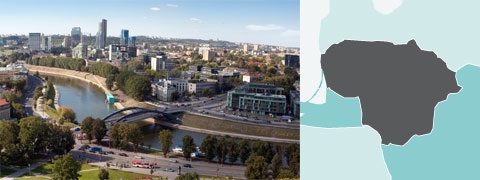Country assessments
Lithuania
- Details
- Country assessments
2013 sector transition indicators
Source: EBRD.
Note: Water – Water and wastewater; IAOFS – Insurance and other financial services; PE – Private equity.
Highlights
- Following a change in administration at the end of 2012, the authorities have placed a strong emphasis on social policies and reducing income inequality.
- A mid-sized domestic bank, Ukio Banka, failed in February 2013. While financial and macroeconomic stability was not jeopardised, this corporate failure once again highlighted the need for far more stringent regulation and supervision of the remaining domestically owned banks.
- Voters rejected plans for the construction of a nuclear power plant. The plant would have served the Baltic region but, although the referendum of October 2012 was non-binding, the result is likely to be followed by the new government.
Key priorities for 2014
- Lithuania should continue its efforts to comply with Maastricht conditions and prepare for eurozone accession. These targets remain priorities, notwithstanding the current vulnerabilities, and uncertain governance, of the monetary union.
- Enhancing energy security and reducing dependence on energy imports from Russia remain key policy priorities. A new liquefied natural gas (LNG) plant is planned to come on-stream in 2014, which should assist in these aims.
- The government should persevere with labour market reforms aimed at giving appropriate incentives to employers. Labour force participation remains below the European Union (EU)-wide target, and adverse demographic trends pose a further challenge.
Macroeconomic performance
A strong recovery in 2012 has continued in 2013. With a 3.7 per cent GDP expansion last year, Lithuania was the second-fastest growing economy in the EU, although a substantial (around 5 per cent) gap in output compared to pre-crisis levels remains. The rate of growth in output growth over the first half of 2013 remained stable, at 3.6 per cent, and remains strongly driven by both external factors and domestic demand, although the latter has lost some momentum since late 2012.
Labour market dynamics improved significantly over the last year. The unemployment rate fell further to reach its lowest level since early 2009, at 11.9 per cent in September 2013. The trend is driven by reductions in youth unemployment, which fell by 4.7 per cent in the year to September 2013, and long-term joblessness (of more than one year’s duration), which decreased significantly but still remains at about half of total unemployment. Further, average wages increased by 2.9 per cent in annual terms in the second quarter of 2013. This represents the greatest quarter-on-quarter increase in average wages since 2008, and was driven by an 18 per cent increase in the minimum wage in January 2013.
Export growth reached 11.9 per cent in 2012, and was the main driver of Lithuania’s recovery. Export growth remained high despite the recession in the eurozone and a sharp narrowing of current account deficits in some peripheral economies. This strong performance is underpinned by much-improved competitiveness indicators. With nominal wage reductions in the face of the financial crisis, real unit labour costs dropped by over 16 per cent during the four years between 2009 and 2012. However, with recent signs indicating increasing wages, Lithuania's export competitiveness could be undermined. On the other hand, early signs of improved consumer confidence indicators in Germany, and relatively broad diversification of export markets – Scandinavia, Poland and Russia, in particular – will support the sustained positive performance of exports.
Fiscal performance improved significantly. On the back of strong economic growth and temporary expenditure cuts, the budget deficit narrowed to 3.2 per cent of GDP, from 5.5 per cent in the previous year. Although the minimum wage increase will lead to a larger public sector wage bill, higher personal income tax revenues are forecast to largely offset this increase, and the fiscal deficit is expected to drop below the Maastricht-compliant level of 3 per cent of GDP. Given the precariously high budget deficit levels after the 2008-09 financial crisis, public debt has almost tripled over the last five years. This trend has now been reversed, and, according to the European Commission’s forecast, public debt will be around 40 per cent of GDP by the end of 2013.
Major structural reform developments
The new government has eased the social impact of austerity measures. After taking office in December 2012, the government embarked on policies targeted at reducing income inequality. This included an 18 per cent increase in the minimum wage, which affects approximately 50,000 public sector employees. Major tax reforms, such as the reintroduction of the progressive income tax, reduction of value-added tax on basic food products, implementation of a new levy on real estate, and a tax on financial transactions, are still to be implemented.
The structure of unemployment benefits was changed to encourage active job seekers. In April 2013 the Labour Ministry introduced a ceiling on unemployment benefits of €101.40 per month (around 20 per cent of the average net wage), and a scheme of gradual reductions depending on length of unemployment. According to the proposal, unemployment benefits would halve after five years of continuous unemployment.
Meeting the Maastricht criteria and the euro adoption timetable have been postponed. In January 2013 the prime minister and the central bank governor pledged to adopt the euro by 2015. The government launched a programme to curb inflation through administrative and fiscal mechanisms, such as amendments to taxation laws, including tax exemptions, and reducing heating prices. The timeframe of these measures has been delayed by one year from the timetable of the previous government. Consumer prices edged down by 0.2 per cent month-on-month in June, bringing the 12 month moving average inflation rate to 2.4 per cent – its lowest level since 2011 and below the Maastricht criterion for inflation.
The government’s policies on flagship energy security projects remain unclear. The investment in the Visaginas nuclear power plant was effectively put on hold after it was voted down in a referendum held in parallel with the parliamentary elections in October 2012. However, in April 2013, the government decided to restart negotiations over project costs with Lithuania’s Baltic neighbours and the contractor. The restart of these discussions has not yet yielded any binding decisions about the future of the project, and resumption of the project remains doubtful. Similarly, the cabinet’s commitment to shale gas exploration is questionable, given that the Lithuanian parliamentary committee on environmental protection voiced its concerns and called for a thorough investigation of the project’s environmental impact, as well as for adequate social consultations.
The LNG terminal in Klaipeda remains the main pillar of the county’s energy policy. The LNG re-gasification terminal received renewed political support from the new government, and financial backing was confirmed from international lenders. Consequently, the plant is expected to become fully operational in December 2014, with the capacity to supply Lithuania’s entire annual demand, which will reduce the country’s dependence on gas imports from Russia. Legislation which stipulated that certain large domestic gas consumers would purchase 25 per cent of their supply from the terminal was challenged under EU competition policies. The legislation had to be reversed, which undermined the commercial viability of the project. However, this development will help promote competition in gas supply in the region. The government is currently in advanced talks with the Qatari gas company concerning the gas supply to the terminal in Klaipeda.













